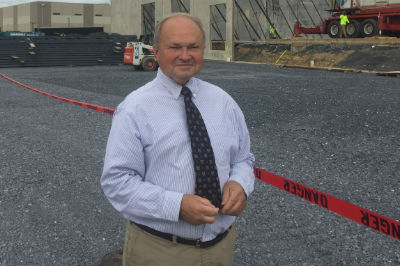The following is a letter from former Augusta County Board of Supervisors Chairman Tracy Pyles to Augusta County Circuit Court Judge William Chapman Goodwin.

Dear Judge Goodwin,
I hope the Court will receive and consider this inexpert “Friend of the Court” petition. The purpose is to offer a recap of the 2016 Referendum and why faithful allegiance to the peoples’ voice, the people’s recorded vote, requires a re-vote not a loss of primacy to an unelected third party.
Whether it was the Board of Supervisors simply waving a white flag, or the Court weary of the lack of progress, I believe this order to be premature. Respectfully, I do not believe the Court should be deciding what the County is to build and how much is to be spent. It blurs the lines in our established separation of powers. Another vote will put the authority back where it belongs, with the people.
But to avoid a repeat of this present mess, we must recognize what went wrong.
Actions, over the last four years, by the Augusta Board of Supervisors have displayed the difficulty of pleasing everyone. A main cause of this problem can be traced to the General Assembly. The General Assembly’s mandated Referendum verbiage was likely designed to thwart a court’s relocation. By inserting the cost to move, but not the cost to stay, it denied a true choice for the voters.
Had the referendum offered, “choose one”: Verona Courthouse $45 million or Staunton Courthouse $59 million. The result would have been clear instead of ambiguous. Instead we are left to wonder if the people were voting against the move or the cost.
The following year, as Chairman, I asked my fellow Supervisors to contract with Lineage Architects for Courthouse plans, in Staunton, that were less than $45 million. The hope was to provide a way to serve both staying in Staunton and spending less than the Verona cost.
Lineage prepared a beautiful meshing of the old building and a new structure for less than $40 million. However, Staunton City Council ended this project (included); by both denying and scolding Augusta County.
The following year the Supervisors, then and now under Chairman Gerald Garber, decided to erect a Courthouse in Staunton no matter the cost. First, a $70 million court plan was swept away when contemporaneous flooding on Johnson Street gave understanding to the “floodplain” designation on their proposed building site.
Next was a plan, seemingly given the “green light” by a newly elected Council, to build in the Historic District. This $60 million-plus plan was subsequently disallowed by Staunton authorities on learning the Historic District mattered to its citizens.
Finally, the Augusta Board sought a Courts Complex that ignored the Supreme Courts’ Guidelines against multi-building projects and voter cost concerns. In this case bank greed played a part in ending this last resort effort.
In total, these planning efforts have cost county tax-payers somewhere around $1.5 million. While this money has seemingly been spent with no good end; what it does demonstrate is a good faith effort to meet all the Court’s needs. It has not been the case, as in other instances of provoking similar writs of mandamus that the County has been unable or unwilling to invest in facility improvements.
As proof, the Supervisors have been willing to exceed what the people had rejected: $45 million. The dead-ends were not County caused. Staunton City, and well-funded special interest groups, worked to both stop a move and to reasonably construct in Staunton.
The included April 18, 2017 letter from Mayor Dull essentially sums up the tone and intensity of the resistance to023 enlarging in Staunton’s downtown. It is an Historic District, in large part, due to presence of the Augusta County Courthouse. And yet, the City, its leaders and its people, oppose enlarging the Courthouse, as necessary, to meet today’s and tomorrow’s need.
Consider then Staunton’s legal community’s self-serving work to mislead County voters. I have included just one piece of their literature. But offer a few of their comments here to encourage the Court’s full reading.
Considering space needs: “new additions add 2,910 square feet and reconfiguration of historic courthouse will meet all needs including new conference & restrooms”.
Historic Records: “installation of proper HVAC system will control moisture, vapor, humidity levels: new record storage equipment & technology including high speed-speed scanning & retrieval equipment”. That was all they wrote. Nothing about the greater problem of hardly having room to breathe in the basement storage.
Concerning cost: “Renovations of the Augusta County historic courthouse will meet the public’s needs for years to come, at a lower cost to taxpayers!” If, only.
This information was developed and distributed by the Common Sense Solutions political action committee presided over by Staunton Attorney Duane Barron. Besides distributing misleading literature, Barron sought to insure a hesitancy by Augusta County to fairly responding to their untruths.
Barron wrote (included) to then Augusta Chairman Carolyn Bragg this inherent threat: “We are concerned that your activities have crossed the line from providing neutral, educational materials to those of an advocacy group promoting the passage of the measure.”
It was a $90,000 effort funded by a “who’s who” of Staunton elite determined to have Augusta taxpayers pay for the largest investment ever in Staunton’s downtown. I have attached a list of the donors. This money was then used to hire the most powerful lobbyists in Virginia: McQuire Woods.
Their Chairman, Richard Cullen, personally donated $6,000 insuring that the best efforts of a law firm, exceeding 1,000 attorneys, might be used to dissuade County voters from saying “yes” to the move. It was not a fair fight.
Given the ambiguity of the Referendum vote, the disinformation given the façade of integrity when coming from Judges and lawyers, and Staunton’s resistance to allow practical construction, the best solution rests in a re-vote.
But prior to another Referendum we need the Court’s help. To insure that the County can provide “neutral, educational materials”, information needs to be generated by an impartial third party. It is here I believe the Court can play a key role in securing a Courthouse the Judicial system deserves and the county can afford.
I am requesting the Court ask the Supreme Courts’ Site Planning resources to evaluate the various works already prepared for the Board of Supervisors. In particular, I would ask they review the 2016 Moseley Plan for Verona, the 2017 Lineage Plan for Staunton and one of the 2021 Moseley Plans for Staunton.
Let them evaluate and objectively report how each plan adheres to the Supreme Court Guidelines. Then have a qualified third party determine comparative costs. Publish the findings.
What is best will likely become apparent. But no matter the result the choice needs to rest with the people.
Requiring the work be completed by December 31, 2021 could allow for a May vote. If the Court can order this, I hope the Court will.
If it can’t; the Court, the Board of Supervisors and Augusta voters need to request that Senator Hanger, Delegates Avoli, Campbell, and Runion lead a legislated change from 10 years to 5, the interval between Referendum votes.
If all this fails, I hope the Court will not push the County where its taxpayers do not wish to go. But rather have the courts soldier on, as they have, until 2026.
Sincerely,
Tracy C. Pyles Jr.
Augusta County taxpayer










